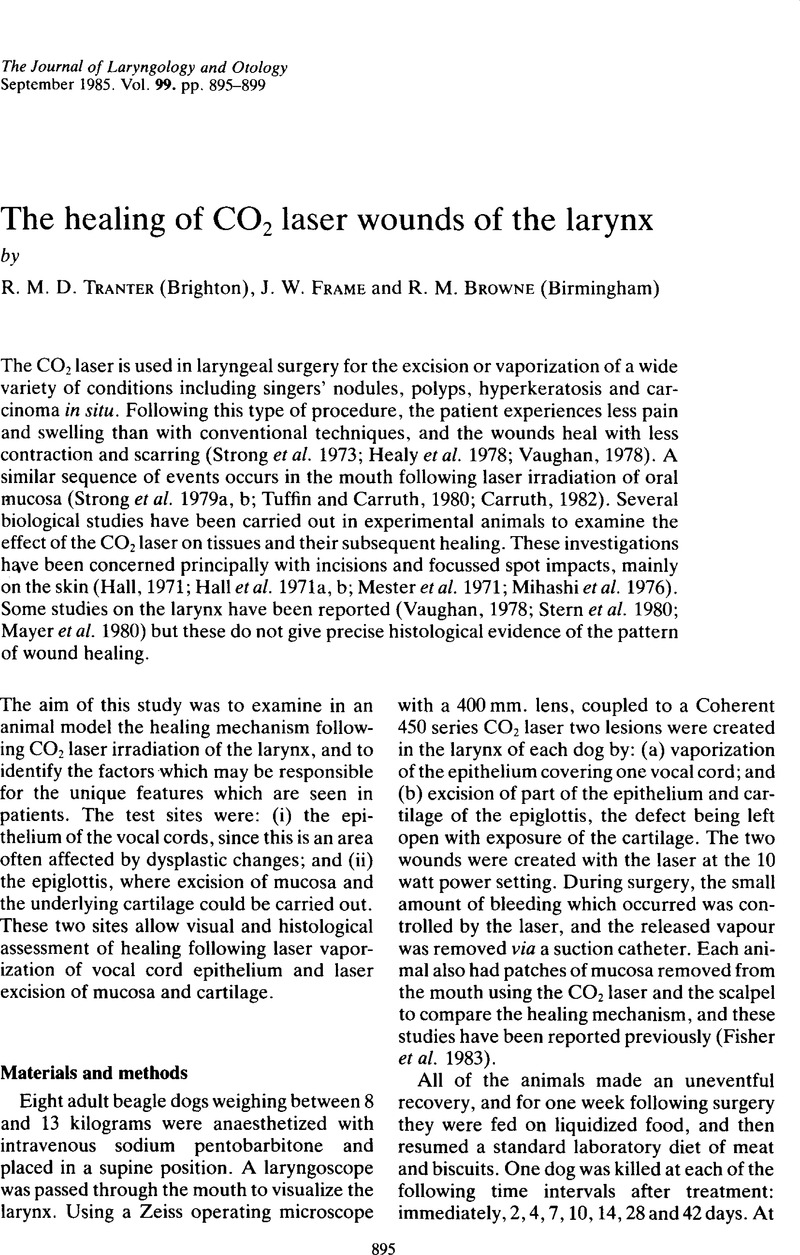Crossref Citations
This article has been cited by the following publications. This list is generated based on data provided by Crossref.
Parker, D. A.
and
Gupta, A. R. Das
1987.
An endoscopic silastic kell for anterior glottic webs.
The Journal of Laryngology & Otology,
Vol. 101,
Issue. 10,
p.
1055.
Robinson, P. M.
and
Weir, A. M.
1987.
Excision of benign larygeal lesions: comparison of carbon dioxide laser with conventional surgery.
The Journal of Laryngology & Otology,
Vol. 101,
Issue. 12,
p.
1254.
Vorre, P.
Illum, P.
Oster, S.
Reske-Nielsen, E.
and
Larsen, K. B.
1989.
Morphology of Tracheal Scar after Resection with CO2-laser and High-frequency Cutting Loop:A Study in Normal Pigs.
Acta Oto-Laryngologica,
Vol. 107,
Issue. 3-4,
p.
307.
Sheppard, LisaMarie
Werkhaven, Jay
Mickelson, Samuel
Crissman, John D.
Peterson, Edward
and
Jacobsen, Gordon
1992.
Effect of steroids or tissue preceding on edema and tissue thermal coagulation after CO2 laser impact.
Lasers in Surgery and Medicine,
Vol. 12,
Issue. 2,
p.
137.
Hendrick, David A.
and
Meyers, Arlen
1995.
Wound Healing after Laser Surgery.
Otolaryngologic Clinics of North America,
Vol. 28,
Issue. 5,
p.
969.
Rogerson, Anthony R.
Clark, Keith F.
Bandi, Somasekhar R.
and
Bane, Barbara
1996.
Voice and healing after vocal fold epithelium removal by CO2 laser vs. microlaryngeal stripping.
Otolaryngology–Head and Neck Surgery,
Vol. 115,
Issue. 4,
p.
352.
Laranne, J.
Pukander, J.
Puhakka, H.
Rantala, I.
Harmoinen, A.
and
Holm, P.
1997.
Longterm comparison of soft palate scars after UPPP made by CO2, contact Nd-YAG or combined CO2 and Nd-YAG laser beams.
Lasers in Medical Science,
Vol. 12,
Issue. 4,
p.
347.
Hatano, Izumi
Suga, Toshimitsu
Diao, Edward
Peimer, Clayton A.
and
Howard, Craig
2000.
Adhesions from flexor tendon surgery: An animal study comparing surgical techniques.
The Journal of Hand Surgery,
Vol. 25,
Issue. 2,
p.
252.
Werner, J. A.
2002.
Lymphknotenerkrankungen im Kopf-Hals-Bereich.
p.
3.
Misiolek, Maciej
Namyslowski, Grzegorz
Nozynski, Jerzy
Karpe, Jacek
Czecior, Eugeniusz
Scierski, Wojciech
and
Misiolek, Hanna
2004.
Local Complications after Laser Arytenoidectomy due to Bilateral Vocal Cord Paralysis.
Medical Laser Application,
Vol. 19,
Issue. 2,
p.
109.
Knott, P Daniel
Byrd, Michael C.
Hicks, David G.
and
Strome, Marshall
2006.
Vocal Fold Healing after Laser Cordectomy with Adjuvant Cryotherapy.
The Laryngoscope,
Vol. 116,
Issue. 9,
p.
1580.
Jeong, Woo-Jin
Kim, Heejin
Ahn, Jae-Cheul
Sung, Myung-Whun
Kim, Kwang Hyun
and
Ahn, Soon-Hyun
2012.
Serial endoscopic analysis of the glottis following laser cordectomy: from an oncological perspective.
Lasers in Medical Science,
Vol. 27,
Issue. 5,
p.
1025.
Priyadharshini., S
Gopal., K Saraswathi
Kumar., P Mahesh
and
Lankupalli, Arathy S.
2024.
Efficacy of Diode Laser in Excisional Biopsy of Soft Tissue Lesions in Oral Cavity and Assessment of Their Wound Healing – A Prospective Clinical Study.
Journal of Indian Academy of Oral Medicine and Radiology,
Vol. 36,
Issue. 2,
p.
132.



